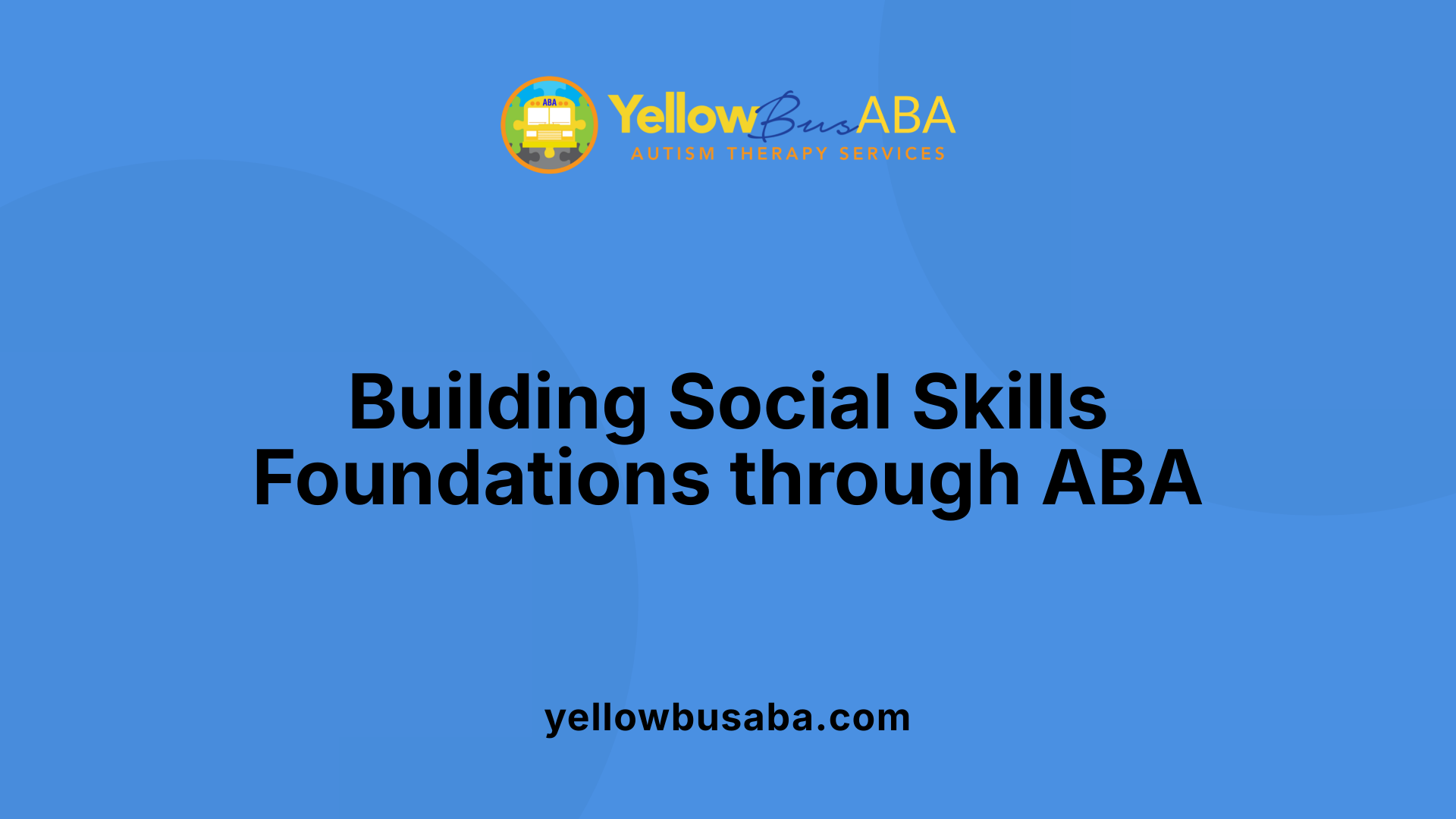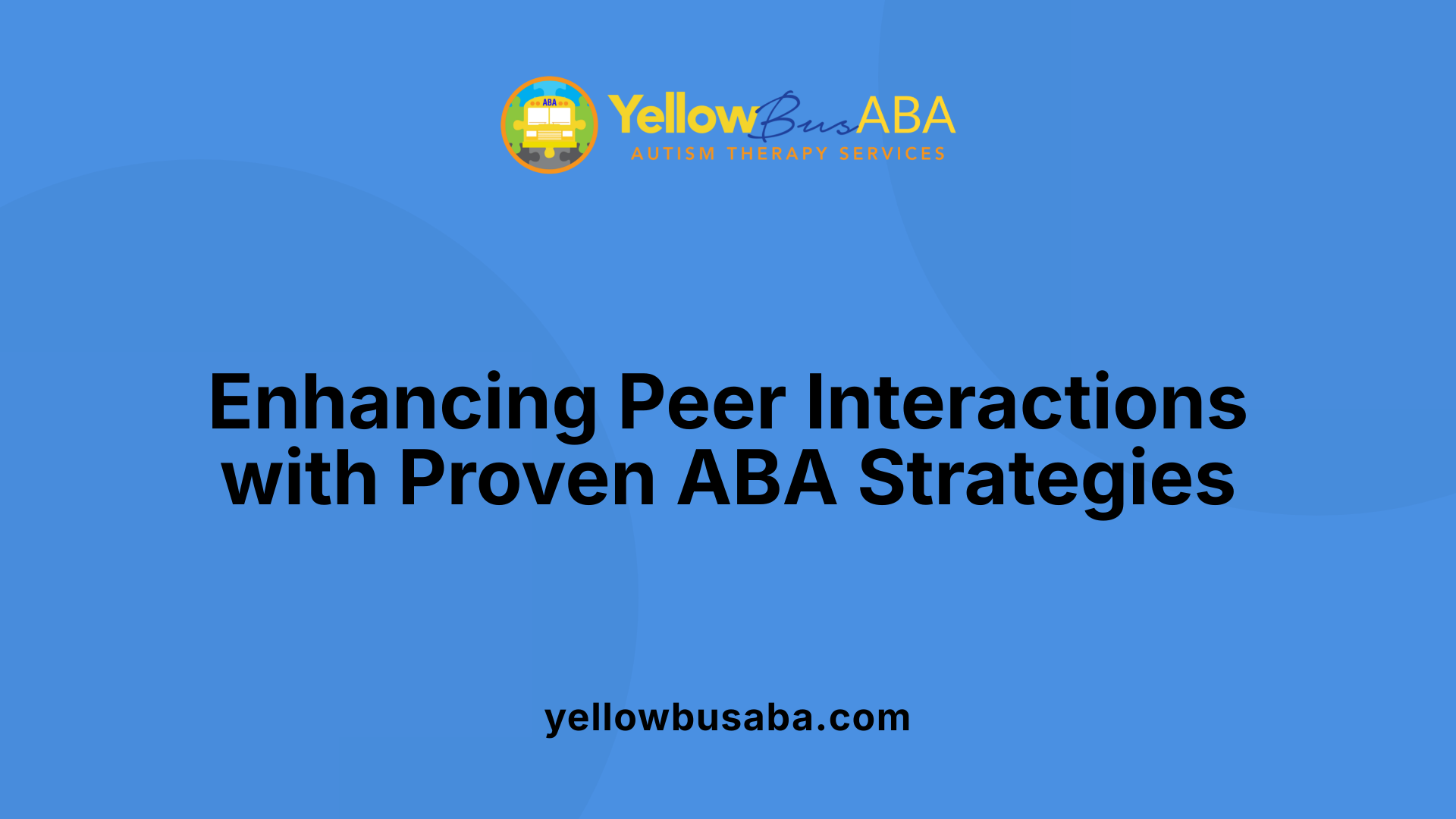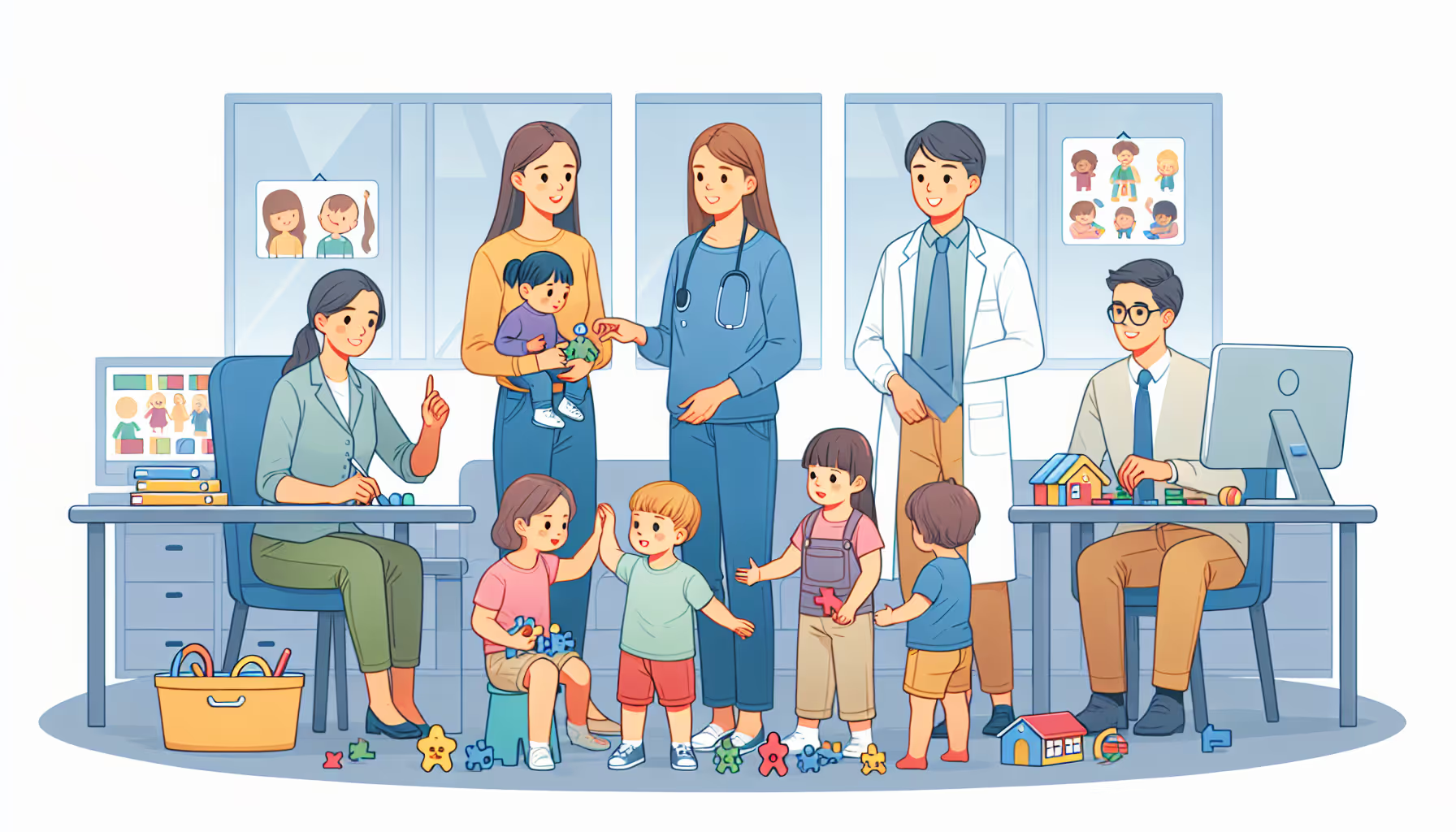How ABA Therapy Helps Children Navigate Peer Relationships
August 26, 2025
Building Connections: The Power of ABA in Supporting Children's Social Journeys

Understanding How ABA Therapy Facilitates Peer Relationship Skills
ABA therapy is a proven, evidence-based approach that helps children, particularly those with autism spectrum disorder (ASD), develop vital social skills necessary for meaningful peer relationships. This therapy employs structured teaching strategies, personalized interventions, and active parental involvement to nurture children’s social potential and enable them to navigate the complex world of peer interactions effectively.
Foundations of Social Skills Development in ABA Therapy

How does ABA therapy support social skill development in children?
ABA (Applied Behavior Analysis) therapy plays a vital role in helping children develop essential social skills. It uses evidence-based, individualized strategies aligned with each child's unique needs and strengths. The goal is to teach behaviors that promote positive interactions, such as initiating conversations, understanding social cues, sharing, and empathizing with others.
Therapists often employ structured methods like social stories, role-playing, and group activities that simulate real-world social situations. These activities break down complex social behaviors into manageable steps, making it easier for children to learn and practice.
Reinforcement is a core component of ABA, where positive behaviors are rewarded to encourage their repetition. Natural environment teaching helps children apply skills outside of therapy sessions, ensuring that social behaviors are integrated into everyday life.
Moreover, ABA emphasizes improving non-verbal communication—interpreting facial expressions, gestures, and tone of voice—to facilitate better understanding of social cues. Parent involvement and regular assessments support consistent reinforcement and progress tracking.
In summary, ABA therapy supports social skill development through a combination of tailored interventions, practical activities, and ongoing support, empowering children to build meaningful relationships and navigate social environments more effectively.
Strategies and Techniques to Enhance Peer Interactions

What methods and strategies are used in ABA therapy to improve peer interactions?
ABA therapy utilizes a diverse set of methods and techniques aimed at strengthening children's ability to interact positively with their peers. Central to these strategies are positive reinforcement, role-playing, and social stories, which serve as practical tools to teach and practice social skills.
One highly effective approach involves peer-mediated interventions. These involve training selected peers—who are often empathetic and patient—to support children with autism through structured activities. These activities include group games, collaborative projects, and naturalistic teaching environments that mirror everyday social situations. Such interactions promote essential skills like communication, turn-taking, cooperation, and sharing.
The selection of appropriate peers is vital; they are trained to understand and support the social and pragmatic needs of children with autism. This training enhances their ability to model appropriate behavior and reinforce positive social interactions.
In addition to peer mediation, evidence-based practices like discrete trial training (DTT), natural environment teaching (NET), and video modeling play significant roles. Visual supports, such as social narratives and social stories, are tailored to each child's experiences to help them understand social cues and expectations.
Visual aids such as emotion charts and social stories help children recognize emotions and navigate social situations more effectively. Video modeling provides visual demonstrations of desired behaviors, allowing children to imitate and generalize these skills to real-world settings.
Reinforcement strategies, focused on rewarding positive behaviors, are critical to motivating children and encouraging consistent social engagement. Prompting techniques—such as verbal cues or gestures—are used to initiate behaviors, with gradual fading to promote independence.
Activities like peer play, collaborative exercises, and the use of technological tools foster motivation and engagement. These methods collectively aim to promote meaningful peer relationships, improve social confidence, and facilitate the generalization of skills beyond therapy sessions into everyday interactions.
Tailoring ABA for Different Developmental Stages

How does ABA therapy help children, especially those with autism, manage peer relationships?
ABA therapy plays a significant role in helping children with autism develop essential social skills that are critical for building and maintaining peer relationships. It focuses on teaching behaviors such as initiating conversations, sharing, taking turns, and understanding social cues, which are foundational to social interactions.
In early childhood, especially between ages 2 and 4, ABA emphasizes foundational skills like joint attention, basic communication, and emotional regulation. Therapists use structured methods like social stories, visual supports, and role-playing to teach children how to interpret facial expressions, gestures, and tone of voice. Reinforcement helps solidify these skills, making social interactions less overwhelming.
As children grow into preschool and kindergarten ages (4-6), ABA therapy expands to include more complex peer interactions such as participating in group activities, following social rules, and expressing opinions respectfully. Through collaborative games and peer-mediated interventions, children practice sharing, turn-taking, and polite language in real-world settings, which helps them generalize these skills beyond therapy.
During the elementary school years (6-10), the focus shifts toward fostering independence in social situations and understanding more nuanced social cues like sarcasm and emotional body language. ABA strategies include skill-building in problem-solving, self-monitoring, and emotional regulation, which support better engagement in classroom activities and social groups.
In adolescence and beyond, ABA therapy adapts to focus on more advanced skills, such as managing conflicts, developing empathy, and navigating complex social environments like extracurricular activities, work placements, or social gatherings. Goals include preparing teenagers for independence, supporting vocational skills, and promoting mental health.
Throughout all stages, ABA’s personalized approach means therapy is tailored to each child's developmental level, strengths, and needs. Consistent assessments and family involvement ensure that skill development continues seamlessly as children grow. Techniques such as naturalistic teaching, social stories, reinforcement, and role-play are adjusted according to age-related capabilities, making the learning process both effective and engaging.
Overall, ABA therapy equips children with the tools to manage peer relationships effectively, fostering social confidence, emotional understanding, and a sense of belonging. This structured yet flexible approach supports children at every stage of development, helping them build lasting friendships and navigate social challenges successfully.
Enhancing Emotional Intelligence and Social Understanding
What is the role of ABA therapy in developing children's emotional intelligence and social understanding?
ABA therapy plays a crucial part in nurturing children’s emotional intelligence and their ability to understand social cues. Using structured, evidence-based techniques, ABA programs teach children to recognize, interpret, and respond appropriately to emotions in themselves and others.
One of the most effective strategies involves modeling appropriate emotional responses. Therapists demonstrate how to interpret facial expressions and social cues, helping children imitate and understand these signals. Positive reinforcement encourages children to practice and internalize emotional behaviors.
Social stories and visual aids like emotion cards are common tools used in ABA therapy. These resources help children grasp complex social and emotional concepts through relatable narratives and visual prompts. For example, social stories might depict a child feeling happy after sharing toys or feeling upset after being ignored, helping children understand the feelings involved.
Teaching empathy and perspective-taking is also a core aspect of social-emotional development in ABA. Children learn to see things from others' viewpoints, which fosters compassion and improved social interactions. Role-playing exercises simulate real-life situations, allowing children to practice understanding others' emotions and responding appropriately.
Building emotional regulation and resilience is vital for managing challenging behaviors and fostering independence. ABA programs incorporate strategies like emotion regulation training, teaching children coping mechanisms such as deep breathing or requesting a break during overwhelming moments.
Early intervention amplifies these benefits. By beginning emotional and social skills training at a young age, children with autism make significant gains in their ability to manage emotions and engage positively with peers and family. This progress often results in enhanced self-confidence, better social relationships, and overall improved well-being.
In conclusion, ABA therapy equips children with the tools to decode emotional cues and respond thoughtfully, laying a foundation for meaningful personal connections and successful social integration. The interplay of modeling, visual supports, social narratives, and active practice makes ABA a comprehensive approach to fostering emotional awareness and resilience in children on the autism spectrum.
Building Confidence and Reducing Social Anxiety

How does ABA therapy help children, especially those with autism, manage peer relationships?
ABA therapy plays a vital role in helping children with autism develop social skills that are essential for forming and maintaining peer relationships. By focusing on behaviors such as initiating conversations, sharing, making eye contact, and understanding social cues, ABA provides children with practical tools to navigate social interactions.
Through structured methods like social stories, role-playing, and positive reinforcement, children learn to interpret emotions, practice taking turns, and engage in collaborative play. These strategies help reduce anxiety related to social situations and build a child's confidence.
The personalized approach of ABA therapy ensures that interventions are tailored to each child’s unique needs and strengths. This individualized focus maximizes their social learning and progress.
In addition to formal therapy sessions, parental involvement and reinforcement at home play a crucial part. Families can support skill generalization by creating opportunities for social practice in everyday settings.
Overall, ABA therapy equips children with essential social communication skills, encouraging successful peer interactions, fostering friendships, and nurturing their overall social confidence.
How effective is gradual exposure to social situations?
Gradual exposure is a core tactic within ABA to help children overcome social fears. Instead of overwhelming a child with full social interactions immediately, therapists break down social situations into manageable steps.
Initially, children might practice simple tasks like making eye contact or greeting someone. Over time, as their comfort grows, they progress to more complex interactions like initiating conversations or joining group activities.
This step-by-step approach builds a child's confidence steadily, making social environments less intimidating and reducing feelings of anxiety.
How do modeling and role-playing serve as confidence builders?
Modeling involves demonstrating appropriate social behaviors for children to imitate. For example, a therapist might show how to greet a peer politely or share toys. Role-playing allows the child to practice these behaviors in a playful, safe setting.
These activities help children understand expectations, gain practice, and receive immediate positive feedback, which bolsters their self-esteem.
Repeated role-playing helps them internalize social norms and increases their comfort in real-world situations.
What is the importance of reinforcing small successes?
Reinforcing small successes is critical in encouraging ongoing social development. When a child successfully initiates a conversation or responds appropriately to a social cue, therapists and parents celebrate these efforts.
This positive reinforcement boosts self-confidence and motivates children to try more social behaviors. Recognizing progress, no matter how minor, fosters resilience and a growth mindset.
How can parents support children in overcoming social fears?
Parents are integral partners in reducing social fears. They can reinforce skills learned in therapy through routines, modeling behavior, and providing social opportunities like playdates.
Creating a predictable and supportive environment helps children feel safe to practice new skills. Praising effort and progress reinforces their confidence.
Additionally, discussing emotions and social scenarios using social stories or visual aids can prepare children for upcoming social interactions.
Through consistent support and encouragement, children gradually become more comfortable, able to face social situations with less anxiety and more confidence.
Long-Term Impact and Benefits of ABA Therapy

Building independence and self-advocacy
ABA therapy plays a crucial role in fostering independence in children with autism. Through structured teaching of self-care routines, daily living skills, and responsibilities, children gain confidence and autonomy that support their transition into adolescence and adulthood. The development of self-advocacy skills, such as expressing their needs and understanding their rights, is also emphasized. These skills empower children to manage their behaviors and make informed decisions, reducing dependence on caregivers.
Generalization of social skills across environments
One of the main strengths of ABA therapy is its focus on helping children transfer learned skills beyond the therapy setting. Techniques such as natural environment teaching, role-playing, and peer-mediated interventions enable children to apply social behaviors in various contexts—at home, school, and community activities. This consistent application promotes more natural and sustained social interactions, helping children form meaningful relationships and participate actively in community life.
Supporting emotional regulation and resilience
ABA therapy involves teaching children to recognize and manage their emotions effectively. Visual supports like emotion charts and social stories, along with coping strategies, help children develop emotional awareness and resilience. Early intervention with approaches like Early Intensive Behavioral Intervention (EIBI) cultivates foundational emotional regulation skills from a young age. Over time, these skills lead to greater emotional stability, reduced anxiety, and improved ability to handle social challenges.
Enhancing overall social inclusion and acceptance
Improved social skills foster acceptance and inclusion within peer groups. Children learn to interpret social cues, share, take turns, and respond appropriately, reducing social isolation. When children develop communication and empathy, they become more relatable and engaging to others. This not only helps in building friendships but also promotes a more inclusive environment where children with autism are valued members of their social communities.
| Aspect | Impact | Description |
|---|---|---|
| Independence & Self-Advocacy | Greater autonomy | Assisting children in managing routines and expressing needs independently |
| Skill Generalization | Broader social engagement | Applying learned skills across settings through naturalistic teaching |
| Emotional Resilience | Better emotional coping | Recognizing emotions and employing coping strategies for social challenges |
| Social Inclusion | Increased peer participation | Developing social communication skills to foster friendships and peer acceptance |
By facilitating these developmental areas, ABA therapy not only improves immediate social interactions but also contributes to long-term personal growth. Children who undergo consistent ABA interventions often experience increased self-esteem, better emotional understanding, and stronger social bonds, ultimately leading to more successful and fulfilling lives.
Fostering Lasting Peer Connections Through ABA
ABA therapy plays a crucial role in empowering children with autism to forge meaningful peer relationships by systematically teaching and reinforcing essential social, communication, and emotional skills. Through individualized strategies, active involvement of families, and real-world practice, ABA facilitates the generalization of these skills across various social settings. As children build confidence and competence in their social interactions, they experience increased self-esteem, reduced anxiety, and a stronger sense of belonging. Ultimately, ABA’s holistic approach to social development prepares children not just to succeed in peer relationships, but to flourish socially, emotionally, and academically, paving the way for more inclusive and supportive communities.
References
- ABA Therapy for Kids: Helping with Friendships and Social Skills
- ABA Therapy's Impact on Peer Interaction and Communication
- ABA Therapy for Different Age Groups: A Guide for Parents
- Building Friendships: Social Skills Development in ABA
- ABA Therapy: A Path to Improved Social Skills in Kids
- How a Child's Age Impacts ABA Therapy Strategies
- Autism and Friendships: Supporting Social Growth | Blossom ABA
- How ABA Therapy Supports Child Development - Radical Minds
- 7 Surprising Benefits of ABA Therapy for Kids You Need to Know
- Teaching Emotional Intelligence with ABA - Therapyland

.avif)




